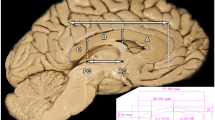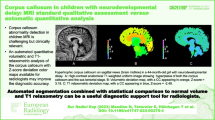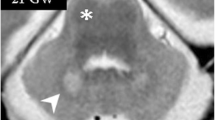Abstract
In recent years interest in the anatomy of corpus callosum (CC) has led to a number of studies on morphometric analysis of CC, either in vivo on magnetic resonance imaging (MRI) or on preserved (formalin-fixed) cadaveric brain specimens. There are very few reports comparing the values obtained by both these methodologies, and to the authors’ knowledge no study of CC morphometry in fresh (unfixed) autopsy brains has been done. Morphometric measurements of the CC were done on fresh autopsy brains (n = 15), preserved cadaveric brains (n = 44) and MRI scans (n = 30) in adults (age range: 20-60 years) of both sexes without any intracranial brain pathology, in north-west Indian subjects. Most of the CC measurements were found to be more in the fresh autopsy brain group as compared to the preserved cadaveric brain and MRI group. The distance between the splenium and superior colliculus in the fresh autopsy brain group was almost twice that in the other two groups. In addition, there was a similarity between the preserved cadaveric brain and MRI values for most of the parameters, but the distances between the genu and fornix and between the genu and anterior commissure were larger in the MRI group as compared to the other two groups. The present data may be of value in studying deviations from the normal in various disease processes as well in surgical planning of intraventricular and callosal pathologies.
Similar content being viewed by others
References
Allen LS, Richey MF, Chai YM, Gorski RA (1991) Sex differences in the corpus callosum of the living human being. J Neurosci 11, 933–42.
Appel FW, Appel EM (1942) Intracranial variations in the weight of the human brain. Hum Biol 14, 235–50.
Banka S, Jit I (1996) Sexual dimorphism in the size of the corpus callosum. J Anat Soc India 45, 77–85.
Bermudez P, Zatorre RJ (2001) Sexual dimorphism in the corpus callosum: Methodological considerations in MRI morphometry. Neuroimage 13, 1121–30.
Byne W, Bleier R, Houston L (1988) Variations in human corpus callosum do not predict gender: A study using magnetic resonance imaging. Behav Neurosci 102, 222–7.
Clarke S, Kraftsik R, Van der Loos LH, Innocenti GM (1989) Forms and measures of adult and developing human corpus callosum: Is there sexual dimorphism? J Comp Neurol 28, 213–30.
Demeter S, Ringo LJ, Doty RW (1988) Morphometric analysis of the human corpus callosum. Hum Neurobiol 6, 219–26.
Doraiswamy PM, Figiel GS, Husain MM et al. (1991) Aging of the human corpus callosum magnetic resonance imaging in normal volunteers. J Neuropsychiatry Clin Neurosci 3, 392–7.
Elster AD, Dipersio DA, Moody DM (1990) Sexual dimorphism of the human corpus callosum studied by magnetic resonance imaging: Fact, fallacy and statistical confidence. Brain Dev 12, 321–5.
Going JJ, Dixson A (1990) Morphometry of the adult human corpus callosum: Lack of sexual dimorphism. J Anat 171, 163–7.
Goncalves- Ferreira AJ, Herculano-Carvalho M, Melancia JP, Farias JP, Gomes L (2001) Corpus callosum: Microsurgical anatomy and MRI. Surg Radiol Anat 23, 409–14.
Habib M, Gayraud D, Oliva A, Regis J, Salamon G, Khalil R (1991) Effects of handedness and sex on the morphology of the corpus callosum: A study with brain magnetic resonance imaging. Brain Cogn 16, 41–61.
Holloway RL, Anderson PJ, Defendini R, Harper C (1993) Sexual dimorphism of the human corpus callosum from three independent samples: Relative size of the corpus callosum. Am J Phys Anthropol 92, 481–98.
Kertesz A, Polk M, Howell J, Black SE (1987) Cerebral dominance, sex, and callosal size in MRI. Neurology 37, 1385–8.
Kier EL, Truwit CL (1996) The normal and abnormal genu of the corpus callosum: An evolutionary, embryologic, anatomic and MR analysis. Am J Neuroradiol 17, 1631–41.
de Lacoste-Utamsing C, Holloway RL (1982) Sexual dimorphism in the human corpus callosum. Science 216, 1431–2.
Luders E, Rex DE, Narr KL et al. (2003) Relationships between sulcal asymmetries and corpus callosum size: Gender and handedness effects. Cereb Cortex 13, 1084–93.
Okamoto K, Ito J, Tokiguchi S (1990) The MR findings on the corpus callosum of normal young volunteers. Nippon Igaku Hoshasen Gakkai Zasshi 50, 954–63.
Oppenheim JS, Lee BCP, Nass R, Gazzaniga MS (1987) No sex related differences in human corpus callosum based on magnetic resonance imagery. Ann Neurol 21, 604–6.
Ota M, Obata T, Akine Y et al. (2006) Age-related degeneration of corpus callosum measured with diffusion tensor imaging. Neuroimage 31, 1445–52.
Parashos IA, Wilkinson WE, Coffey CE (1995) Magnetic resonance imaging of the corpus callosum: Predictors of size in normal adults. J Neuropsychiatry Clin Neurosc 7, 35–41.
Pozzilli C, Bastianello S, Bozzao A et al. (1994) No differences in corpus callosum size by sex and aging. A quantitative study using magnetic resonance imaging. J Neuroimaging 4, 218–21.
Rajapakse JC, Giedd JN, Rumsey JM, Vaituzis AC, Hamburger SD, Rapoport JL (1996) Regional measurements of the corpus callosum: A methodological and developmental study. Brain Dev 18, 379–88.
Rauch RA, Jinkins JR (1994) Analysis of cross sectional area measurements of the corpus callosum adjusted for brain size in male and female subjects from childhood to adulthood. Behav Brain Res 64, 65–78.
Salat D, Ward A, Kaye IA, Janowsky JS (1997) Sex differences in the corpus callosum with aging. Neurobiol Aging 18, 191–7.
Suganthy J, Raghuram L, Antonisamy B, Vettivel S, Madhavi C, Koshi R (2003) Gender and age related differences in the morphology of the corpus callosum. Clin Anat 16, 396–403.
Sullivan EV, Rosenbloom MJ, Desmond JE, Pfefferbaun A (2001) Sex differences in corpus callosum size: Relationship to age and intracranial size. Neurobiol Aging 22, 603–11.
Takeda S, Hirashima Y, Ikeda H, Yamamoto H, Sugino M, Endo S (2003) Determination of indices of the corpus callosum associated with normal aging in Japanese individuals. Neuroradiology 45, 513–18.
Weis S, Kimbacher M, Wenger E, Neuhold A (1993) Morphometric analysis of the corpus callosum using MR: Correlation of measurement with aging in healthy individuals. Am J Neuroradiol 14, 637–45.
Witelson SF (1989) Hand and sex differences in the isthmus and genu of the human corpus callosum. A postmortem morphological study. Brain 112, 799–835.
Witelson SF, Goldsmith CH (1991) The relationship of hand preference to anatomy of the corpus callosum in man. Brain Res 545, 175–82.
Author information
Authors and Affiliations
Corresponding author
Rights and permissions
About this article
Cite this article
Gupta, T., Singh, B., Kapoor, K. et al. Corpus callosum morphometry: comparison of fresh brain, preserved brain and magnetic resonance imaging values. Anato Sci Int 83, 162–168 (2008). https://doi.org/10.1111/j.1447-073X.2008.00227.x
Received:
Accepted:
Issue Date:
DOI: https://doi.org/10.1111/j.1447-073X.2008.00227.x




